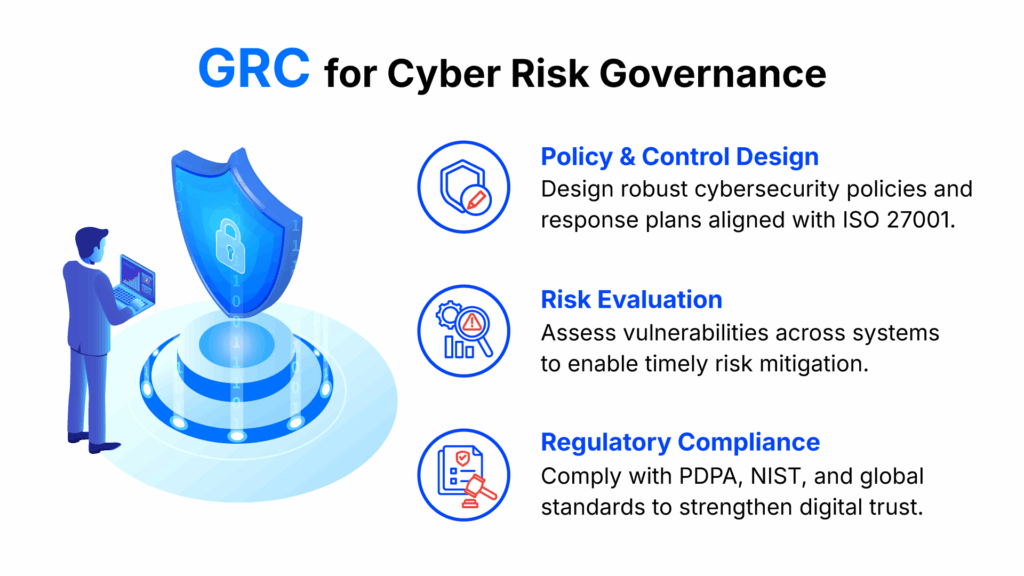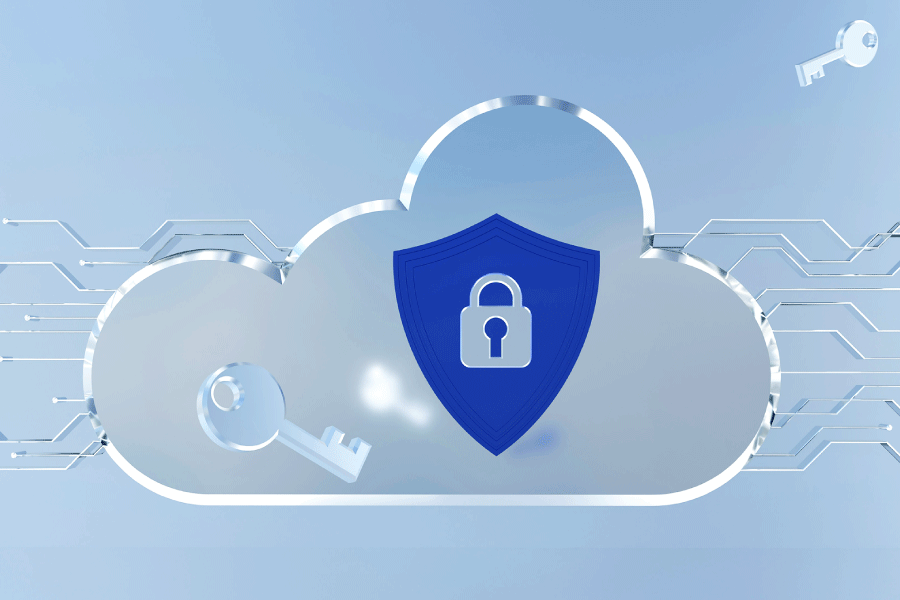
As organizations race to innovate, they must also safeguard integrity, accountability, and resilience. Growth achieved without governance is fragile; progress sustained by trust endures.
This is the essence of the GRC Framework (Governance, Risk, and Compliance) — a management system that strengthens organizational discipline, enhances transparency, and ensures that every decision aligns with both strategic intent and ethical responsibility.
By integrating GRC at the core, enterprises move not only faster but also smarter, safer, and more sustainably.
Redefining GRC for the Modern Enterprise

GRC—Governance, Risk, and Compliance—provides a strategic architecture that enables organizations to govern decisions, manage uncertainty, and measure performance responsibly.
It integrates three pillars—governance, risk management, and compliance—into one coherent system that reinforces organizational trust and resilience.
1. Governance — Steering with Clarity and Purpose
Governance establishes how an enterprise defines its direction and ensures alignment between strategic intent, execution, and accountability. Effective governance sets out the tone for the entire organization — clarifying who makes decisions, how those decisions are made, and how progress is measured.
When done right, it doesn’t just guide operations; it builds confidence that leadership decisions are ethical, transparent, and value-driven.
Core responsibilities of Governance:
- Define strategic direction: Translate corporate vision into actionable goals and governance models.
- Establish guiding policies and standards: Create rules, decision rights, and performance metrics that maintain consistency and control.
- Ensure transparency and accountability: Enable responsible stewardship of resources, ensuring decisions align with enterprise purpose and stakeholder expectations.
Good governance turns strategy into structure—it transforms ambition into disciplined execution.
2. Risk Management — Turning Uncertainty into Foresight
In a rapidly shifting business environment, uncertainty is inevitable. Risk management equips organizations with the foresight and frameworks to anticipate, assess, and address potential threats before they escalate.
It’s not just about avoiding loss—it’s about enabling intelligent risk-taking that supports innovation and sustained growth.
Core responsibilities of Risk Management:
- Identify and assess risks: Evaluate financial, operational, regulatory, and cyber exposures across the organization.
- Quantify and prioritize impact: Determine the significance of each risk and define proportionate mitigation measures.
- Monitor continuously: Track emerging risks and reassess controls to ensure agility and resilience amid constant change.
Proactive risk management turns volatility into a competitive advantage — allowing organizations to move confidently while staying protected.
3. Compliance — Embedding Integrity into Every Action
Compliance is the discipline that anchors integrity across the enterprise. It ensures every process, transaction, and decision operates within the boundaries of applicable laws, standards, and internal ethics frameworks.
Strong compliance doesn’t slow the business down — it builds the trust that allows it to move faster and safely.
Core responsibilities of Compliance:
- Ensure legal and regulatory adherence: Maintain conformity with key frameworks such as Thailand’s Personal Data Protection Act (PDPA), ISO/IEC 27001, and industry-specific standards.
- Operationalize compliance: Embed controls, audits, and training across teams to make compliance part of daily operations.
- Reinforce a culture of responsibility: Build awareness so that employees understand the “why” behind every policy, not just the “how.”
When compliance evolves from obligation to organizational discipline, it becomes a source of confidence for stakeholders — including regulators, partners, and customers. Together, these three pillars form more than a set of policies; they represent the foundation of digital-era trust.
Governance defines direction, risk management protects progress, and compliance preserves integrity.
When integrated effectively, GRC transforms control into capability — empowering organizations to act decisively while upholding the confidence of every stakeholder.
Cyber Resilience Through the GRC Lens
In the digital-first era, cybersecurity has evolved from a technical concern to a strategic business imperative. As operations become data-driven, vulnerabilities increase exponentially — from ransomware and data leakage to regulatory non-conformance.
The GRC Framework enables organizations to manage this complexity through structured cyber risk governance:

- Policy and control design: Develop robust cybersecurity frameworks, incident response protocols, and compliance mechanisms aligned with ISO 27001 and other global standards.
- Risk evaluation: Identify and analyze vulnerabilities across infrastructure, applications, and user behavior. Regular assessments ensure timely detection and remediation.
- Regulatory compliance: Align with privacy and data protection mandates such as PDPA and NIST frameworks, minimizing legal exposure while building stakeholder trust.
Above all, GRC establishes a continuous improvement loop in cyber resilience — ensuring that as threats evolve, controls, processes, and governance adapt in step.
GRC as a Catalyst for Performance Excellence
When implemented effectively, GRC does more than ensure compliance—it enhances enterprise performance. It provides the structure and discipline needed to drive efficiency, accountability, and strategic coherence across the organization.
Key performance outcomes include:
- Risk reduction: Early identification of cross-functional risks minimizes disruptions and protects enterprise value.
- Operational consistency: Clearly defined roles and governance principles improve decision speed and accuracy.
- Process efficiency: Removing duplication and standardizing controls improve collaboration and execution.
- Cost optimization: Proactive risk prevention reduces financial exposure from incidents or regulatory penalties.
Through GRC, organizations transform compliance from an obligation into an enabler of long-term agility and growth.
The Imperative of Continuous Review
A resilient GRC framework must continuously refine itself to meet the changing business landscape. Annual reviews ensure the system remains relevant, responsive, and aligned with the organization’s growth trajectory.

Why annual review matters:
- Regulatory agility: Keep pace with rapidly changing laws such as PDPA and data governance frameworks.
- Technological adaptation: Address emerging risks from AI, cloud, and connected ecosystems.
- Strategic evolution: Align governance and risk oversight with expansion, new business models, and partnerships.
- Operational improvement: Identify maturity gaps and optimize performance across GRC processes.
- Stakeholder confidence: Demonstrate accountability and transparency to investors, clients, and regulators.
From Compliance to Confidence
In a world defined by volatility, trust is the ultimate form of resilience. A mature GRC framework transforms risk into reliability and compliance into confidence—fostering a culture where responsibility and innovation coexist.
GRC is not a bureaucratic layer—it is the architecture of trust. Organizations that invest in it are not merely managing risk; they are building the foundations of sustainable growth. Because in the digital era, trust isn’t a byproduct—it’s the strategy.
Strengthening Enterprise Security with Bluebik Titans
As cyber and regulatory environments become increasingly complex, organizations need a holistic, enterprise-level approach to GRC and security.
Bluebik Titans empowers organizations to build integrated, scalable, and auditable GRC systems that align with their risk profile, business structure, and compliance obligations.
Our solutions are designed to help enterprises achieve measurable governance maturity and sustained trust:
- Security & GRC Advisory: Strategic consulting to assess risk exposure, design governance frameworks, and align with global standards such as ISO/IEC 27001, NIST, and PDPA—helping organizations turn compliance into a level of competitive advantage.
- Risk & Vulnerability Assessment: Comprehensive evaluations of infrastructure and systems to identify weaknesses and design tailored mitigation plans. Includes penetration testing to validate readiness against advanced cyber threats.
- Security Policy Development: Development and refinement of robust security and governance policies that institutionalize best practices across all levels—ensuring consistency, awareness, and traceability in every operation.
- Security Awareness & Training: Targeted programs that cultivate a proactive security culture—cover topics such as phishing, social engineering, and regulatory awareness—because an informed workforce is the strongest line of defense.
Technology drives digital transformation, but trust is what sustains it. Through an integrated GRC approach, organizations can convert compliance into confidence and resilience into a measurable business advantage.












